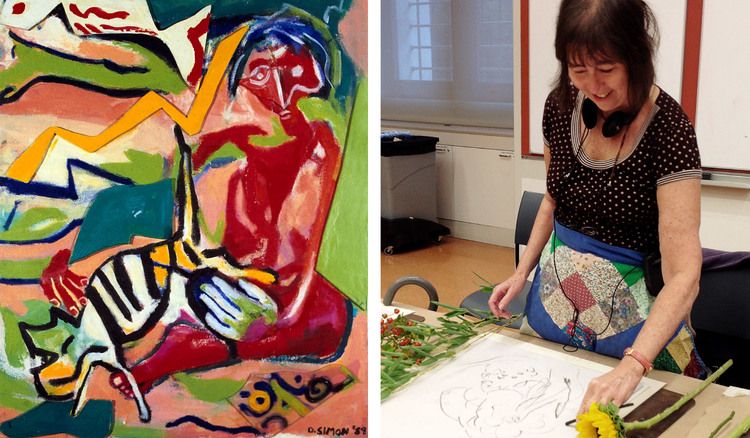An artist with hearing and vision loss drives retinal research using a global online registry
July 27, 2016
Those living with inherited retinal diseases (RDs) share information with physicians and scientists who are hoping to uncover new ways to address inherited forms of vision loss.

Left: Dana Simon’s “Fish Jumped Over the Cat,” mixed media on canvas. Copyright Dana Simon, 1990.
Right: Artist Dana Simon at work.
Growing up with severe hearing loss, I developed into a visual person. By the time I was in college, I’d discovered a love and aptitude for painting, and many other art forms. I even received a grant to get more involved in the art scene with a solo show in New York City’s East Village.
Unfortunately, the rare disease that causes my hearing problems–Usher Syndrome Type 3A (due to mutations in the CLRN1 gene)–also causes progressive vision loss from a retinal degeneration known as retinitis pigmentosa (RP). The result? I am going blind.
I was a teen when I first received my Usher diagnosis, and found the news difficult to believe. However, I soon developed vision problems—first with seeing at night, and then progressive tunnel vision. It was tough, especially in social and work situations. The good news is that after wearing hearing aids most of my life, I received my first of two cochlear implants in 2003, and that has greatly improved both my hearing and my quality of life.
With a progressive condition like Usher syndrome, one that is always changing, I must keep learning new skills. I’ve gained other abilities such as using the computer and teaching computer classes, and these talents eventually landed me a job as a librarian with the New York Public Library.
As a librarian, I’ve learned how important it is to make information and resources available to anyone who needs them. In our world, now more than ever, information and data are essential to our advancement as individuals and a society.
![]()
That’s why I was excited when I received an email from the Foundation Fighting Blindness about its new, online patient registry called My Retina Tracker.
The system provides a way for people with retinal diseases to upload all kinds of information about their condition and vision, so that retinal researchers can study them, understand their causes and effects, and work to develop treatments. In essence, My Retina Tracker is a free and secure online library of information about patients with retinal diseases.
What’s also great is that the system is being used to identify patients for clinical trials of potential therapies. I signed up for My Retina Tracker right away because I saw it as a great opportunity to let researchers know that I was interested in being a candidate for a clinical trial.
I signed up for My Retina Tracker right away because I saw it as a great opportunity to let researchers know that I was interested in being a candidate for a clinical trial.”
There was a lot of information to enter in My Retina Tracker, from details about my eye condition to which doctors I see; thankfully, the system allows you to save your information and continue filling out forms later. I found I was able to go through many of the pages with my screen reader software on my computer. I also had my husband help me with some questions and items that I missed.
To finish my profile, I actually called the Foundation Fighting Blindness and spoke to Joan Fisher, Senior Research Specialist, who was very helpful in enabling me to complete the remainder of the items. My Retina Tracker keeps all of my medical information in one place—a convenience for me—and gives researchers access to information about thousands of people who, like me, are living with blindness.
I am excited about the possibility of participating in clinical trials. My hope is that these trials lead to medical advances that might help me see faces again. I am so sad that I no longer see my husband’s face, nor those of people I meet. Also, I would like to be able to see the details of paintings again. Any improvement in vision would improve the quality of my life.
Shortly before I retired as a librarian, I returned to my interest in art and organized programs to bring art museums to people with low vision. I also wrote several posts and blogs on the New York Public Library web site.
I recently discovered that as a visually challenged person, I am not alone in wanting to get back to my artistic roots—to be able to experience the joy, for example, of going to an art museum. In an effort to help others, I write about my journey as a visually challenged art enthusiast on my website, at www.artandlowvision.com.

Dana Simon
Dana is a recently retired adult and reference librarian with the New York Public Library. She lives in New York City with her husband, Steve. Dana has hearing loss and is legally blind from a progressive condition called Usher Syndrome. As a librarian, she organized several Low Vision Technology Fairs and a series of programs bringing art and museums to people with low vision. Dana writes about museum tours and programs for people with vision loss, and her journey as a visually challenged artist, on her website www.artandlowvision.com.
Sign up to find out when we add new stories to the site.
